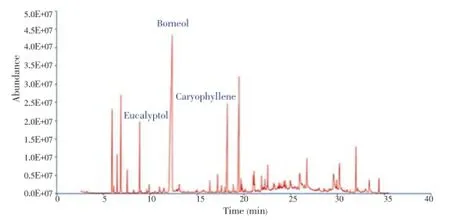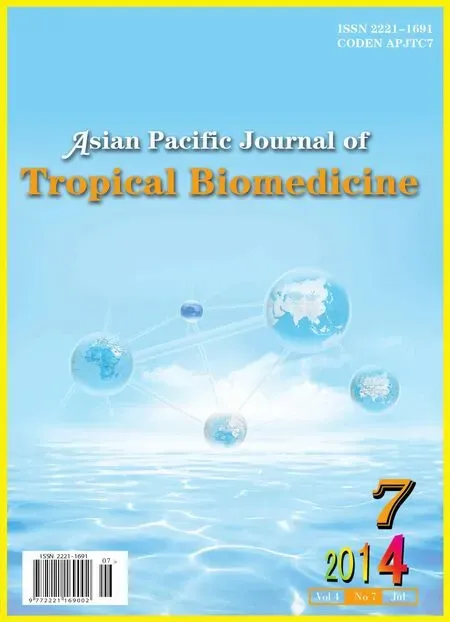The presence of eucalyptol in Artemisia australis validates its use in traditional Hawaiian medicine
David Zant, Daniel A. Gubler
Department of Biochemistry and Physical Sciences, Brigham Young University-Hawaii, 55-220 Kulanui St. #1967 Laie, Hawaii 96762, USA
The presence of eucalyptol in Artemisia australis validates its use in traditional Hawaiian medicine
David Zant, Daniel A. Gubler*
Department of Biochemistry and Physical Sciences, Brigham Young University-Hawaii, 55-220 Kulanui St. #1967 Laie, Hawaii 96762, USA
PEER REVIEW
Peer reviewer
Dr. Taivini Teai, UMR 241 EIO - EIMS team, University of French, Polynesia, P.O. Box 6570 - 98703 Faa’a, Tahiti -French Polynesia.
Tel/Fax: +689 803 822
E-mail: taivini.teai@upf.pf
Comments
This is a valuable research work in which authors have demonstrated traditional use of A. australis against asthma disorder. Here results are based on analysis by GC-MS and the bibliographic search on eucalyptol.
Details on Page 522
Objective:To identify the major organic compounds of Artemisia australis (A. australis), a plant used in traditional Hawaiian medicine for the treatment of asthma.
Artemisia australis, Eucalyptol, Borneol, Traditional Hawaiian medicine, Asthma, Hawaiian endemic plants
1. Introduction
Artemisia australis(A. australis), with the common name of Oahu wormwood and the Hawaiian name of“ahinahina”, is an endemic woody shrub found only on the Hawaiian Islands. It mainly inhabits the windward side of the Islands and prefers growing on the face of exposed cliffs under dry conditions. These shrubs attain a maximum height of ten feet and a diameter of 5 feet.A. australisis a member of the wormwood family of sagebrush-like shrubs with the sweet wormwood [Artemisiaannua(A. annua)] as its most famous member.A. annuahas been used in traditional chinese medicine for thousands of years for a wide range of ailments and contains the potent antimalarial compound artemisinin[1].
The early Hawaiians extensively usedA. australisas a medicinal plant to treat various lung problems, asthma, and other respiratory conditions where no phlegm was produced. The preparation of the plant for the treatment of asthma involved making a tea from the silvery leaves that had been pounded, which the patient was instructed to drink several times a day[2].
Although the flavonoid components ofA. australiswere studied briefly[3], the non-flavonoid compounds in this plant remain a mystery. As part of an effort to provide validity to Hawaiian traditional medicine, we report
*Corresponding author: Prof. Daniel A. Gubler, Ph.D., Brigham Young University-Hawaii, 55-220 Kulanui Street #1967, Laie, Hawaii 96762, USA.
Tel: +1 808 675 3808
Fax: +1 808 675 3825
E-mail: daniel.gubler@byuh.edu
Foundation Project: Supported by the student mentored research fund at Brigham Young University-Hawaii (Grant No. 10-634200-7210).herein the major organic compounds ofA. australisusing gas chromatography-mass spectroscopy (GC-MS) and attempt to correlate the recognized medicinal knowledge of the major components ofA. australiswith its known usage in traditional Hawaiian medicine.
2. Materials and methods
2.1. Plant collection
Samples ofA. australiswere collected on the island of Oahu off of the Farrington Highway (Hwy 930) between the Dillingham Airfield and the end of the road heading towards Ka’ena Point State Park (GPS Coordinates: 21°34.576’N, 158°14.223’W). Samples were collected between February and August 2013. A voucher specimen is stored at the BYU-Hawaii Museum of Natural History.
2.2. Plant extraction
Plant samples were taken back to the laboratory, rinsed with water, and patted dry with a paper towel. In accordance with traditional medicine preparations, the plant was not dried, but used fresh for the extraction. The leaves of the plant were ground in a mortar and pestle and then extracted 4 times using a minimum amount of dichloromethane as solvent. The combined organic extracts were filtered from the plant material, dried with anhydrous sodium sulfate until free flowing, filtered, and then analyzed by GC-MS.
2.3.GC-MSanalysis
A volume of 1 μL of the dichloromethane solution above was then injected into an Agilent 7890A gas chromatograph coupled with a 5975 mass spectrometer (Santa Clara, USA). The column used was an Agilent J&W DB-5HT (5%-phenyl)-methylpolysiloxane (30 m×0.25 mm) with a film thickness of 0.1 μm. The sample was run on splitless mode using helium as the carrier gas with a front inlet temperature of 250 °C and an injection volume of 1 μL. The initial oven temperature was 40 °C with a column flow rate of 1 mL/min and an initial pressure of 11.523 psi. The oven program for the GC was as follows: 1. Start at 40 °C and increase 10 °C/min to 75 °C; 2. Heat at 5 °C/min to 120 °C; 3. Heat at 10 °C/min to 250 °C; 4. Hold at 250 °C for 5 min. The mass spectrometer was programmed with a scan rate of 2.91/s, scan range of 50-550 m/z, MS source temperature of 230 °C, and MS quad temperature of 150 °C. Identification of borneol, eucalyptol, and caryophyllene inA. australiswas first identified by use of the National Institute of Standards and Technology MS Search 2008 library and confirmed by peak enhancement studies using authentic samples purchased through Sigma-Aldrich Co. (St. Louis, USA).
3. Results
Figure 1 is the GC-MS trace of the dichloromethane extract ofA. australis. The major, readily identifiable components of the plant include eucalyptol, borneol, and caryophyllene. It was anticipated that the GC-MS trace would reveal the presence of the well-known antimalarial drug artemisinin, which was present in large amounts in the sweet wormwood (A. annua) plant (Bhakuniet al, 2001)[4]. Artesunate, a semisynthetic derivative of artemisinin, has been reported to be effective in the treatment of asthma and its clinical use is currently under consideration[5]. However, after extensive experimentation, method optimization, and comparison with an authentic sample, no artemisinin was detected inA. australis.

Figure 1. GC-MS trace of the dichloromethane extract of A. australis.
4. Discussion
Upon seeing that artemisinin was not present inA. australis, we searched the scientific literature for the documented medicinal properties of the major components present in the plant. We were pleased to find that eucalyptol, the sixth most abundant compound, has been shown to be effective for the treatment of asthma in a double-blind, placebo-controlled trial[6]. As the name implies, eucalyptol is one of the major components of the eucalyptus essential oil, which is often used for the treatment of respiratory ailments[7]. The presence of this compound in the leaves ofA. australisprovides validity to its preparation and usage in traditional medicine practiced anciently and continued to this day for the treatment of asthma and other respiratory impairments.
As seen in Figure 1, the major component (38% by peak area) of the dichloromethane extract ofA. australisis borneol. Although not used for the treatment of asthma or other respiratory conditions, borneol is known to increase the absorption of other drugs into different organs in the body. A recent report by Luet al.showed that borneolenhanced the absorption of a small molecule (geniposide) in the nasal cavity of rats[8]. Perhaps the borneol in the leaves ofA. australisacts by the same mechanism and allows eucalyptol to be absorbed into the lungs at a larger concentration-thus providing a higher effective dose.
In summary, the major components ofA. australishave been identified and include eucalyptol and borneol. The biological activity of eucalyptol and the potentiating effect of borneol match very well with the usage ofA. australisin Hawaiian traditional medicine. An intriguing question arising from this work is the following: how did the Hawaiians come to know that the leaves ofA. australiswere useful for the treatment of asthma? It is hoped that this work and other projects underway in our laboratory will help to provide scientific support for the practice of traditional medicine in the Hawaiian Islands.
Conflict of interest statement
We declare that we have no conflict of interest.
Acknowledgements
We would like to acknowledge the student mentored research fund at Brigham Young University-Hawaii (Grant No. 10-634200-7210) for financing this work, Dr. Gerald Carr for help in locatingA. australison the island of Oahu, Mr. Aaron Sanders for helpful discussions, and Mr. Nathan McDonald for assistance with plant collection.
Comments
Background
Determination of the biological activity of an endemic medicinal plant is important for the recognition of local people’s traditional knowledge. Moreover, 200-300 million people worldwide are affected by asthma. Therfore, there is a need to identify new natural resources to prevent this disease.
Research frontiers
The present research work depicts the presence of eucalyptol in dichloromethane extract of fresh leaves of an endemic plant,A. australis. Thus, this identification allows to validate the traditional use of this plant for the treatment of asthma.
Related reports
Artemisiagenus and eucalyptol are reported to attenuate experimental allergic asthma. The folklore medicine has evidence of effectiveness of herbs in treating respiratory disorders.
Innovations and breakthroughs
A. australisis an endemic medicinal plant of the Hawaiian islands, used to treat asthma. In this study, authors have identified for the first time the presence of eucalyptol or 1,8-cineol, known to regulate airway mucus hypersecretion and asthma.
Applications
A. australishas already been used by Hawaiian people. Thus, this study suggests the development of the culture of this plant, and the establishment of a quality control and monitoring of concentrations of active compounds.
Peer review
This is a valuable research work in which authors have demonstrated traditional use ofA. australisagainst asthma disorder. Here results are based on analysis by GC-MS and the bibliographic search on eucalyptol.
[1] Klayman DL. Qinghaosu (artemisinin)-an antimalarial drug from China. Science 1985; 228(4703): 1049-1055.
[2] Gutmanis J. Hawaiian herbal medicine. Waipahu, HI: Island Heritage; 2001.
[3] Valant-Vetschera KM, Fischer R, Wollenweber E. Exudate flavonoids in species of Artemisia (Asteraceae-Anthemideae): new results and chemosystematic interpretation. Biochem Syst Ecol 2003; 31(5): 487-498.
[4] Bhakuni RS, Jain DC, Sharma RP, Kumar S. Secondary metabolites of Artemisia annua and their biological activity. Curr Sci 2001; 80(1): 35-48.
[5] Cheng C, Ho WE, Goh FY, Guan SP, Kong LR, Lai WQ, et al. Anti-malarial drug artesunate attenuates experimental allergic asthma via inhibition of the phosphoinositide 3-kinase/akt pathway. PLoS One 2011; 6(6): e20932.
[6] Worth H, Dethlefsen U. Patients with asthma benefit from concomitant therapy with cineole: a placebo-controlled, double-blind trial. J Asthma 2012; 49(8): 849-853.
[7] Cermelli C, Fabio A, Fabio G, Quaglio P. Effect of eucalyptus essential oil on respiratory bacteria and viruses. Curr Microbiol 2008; 56(1): 89-92.
[8] Lu Y, Du SY, Chen XL, Wu Q, Song XA, Xu B, et al. Enhancing effect of natural borneolon the absorption of geniposide in rat via intranasal administration. J Zhejiang Univ Sci B 2011; 12(2): 143-148.
10.12980/APJTB.4.2014C1112
Article history:
Received 15 Feb 2014
Received in revised form 27 Feb, 2nd revised form 15 Mar, 3rd revised form 2 Apr 2014
Accepted 12 Jun 2014
Available online 28 Jul 2014
Methods:The dichloromethane extract of A. australis was analyzed by gas chromatographymass spectroscopy and major compounds were identified by a National Institute of Standards and Technology library search and confirmed by peak enhancement.
Results:The major chemical components of A. australis include eucalyptol, borneol, and caryophyllene.
Conclusions:The presence and biological activity of eucalyptol correlate very well with the usage of this plant in traditional Hawaiian medicine.
 Asian Pacific Journal of Tropical Biomedicine2014年7期
Asian Pacific Journal of Tropical Biomedicine2014年7期
- Asian Pacific Journal of Tropical Biomedicine的其它文章
- Reticulo-cutaneous fistula due to the ingestion of a long metallic rod in a cow
- Clinical, radiological and molecular diagnosis correlation in serum samples from patients with osteoarticular tuberculosis
- Anti-diabetic effects of Caulerpa lentillifera: stimulation of insulin secretion in pancreatic β-cells and enhancement of glucose uptake in adipocytes
- Down-regulated expression of NPM1 in IMS-M2 cell line by (-)-epigallocatechin-3-gallate
- Knowledge, attitude, and practices related to cutaneous leishmaniasis in an endemic focus of cutaneous leishmaniasis, Southern Iran
- An initial study of insect succession on decomposing rabbit carrions in Harare, Zimbabwe
